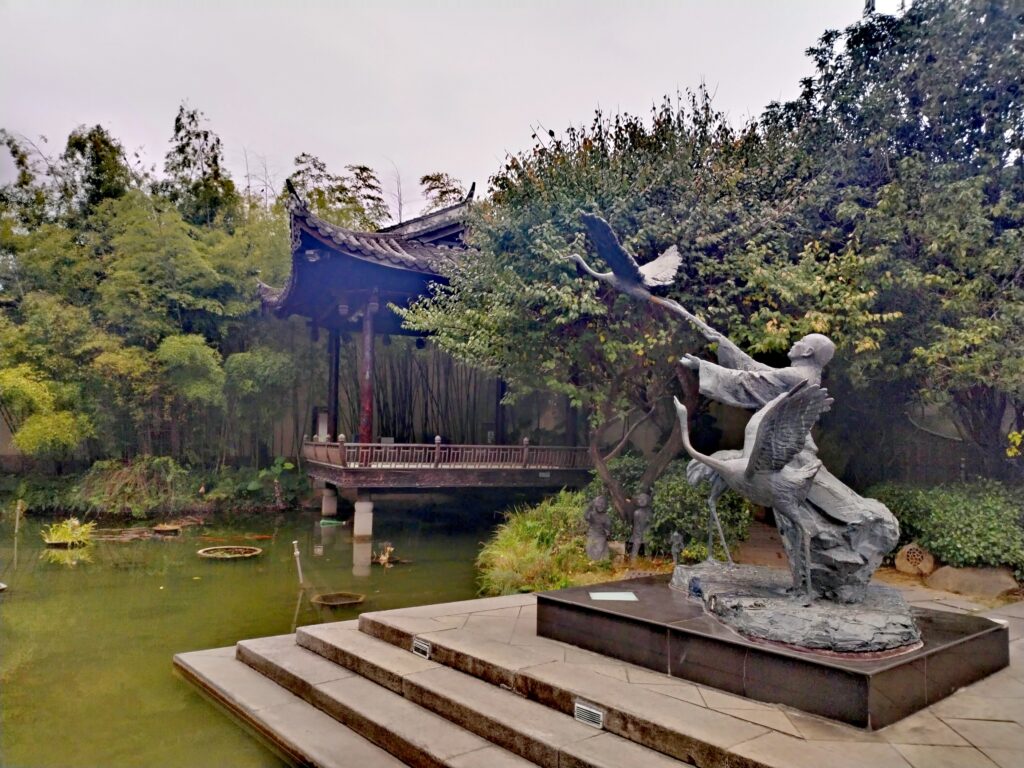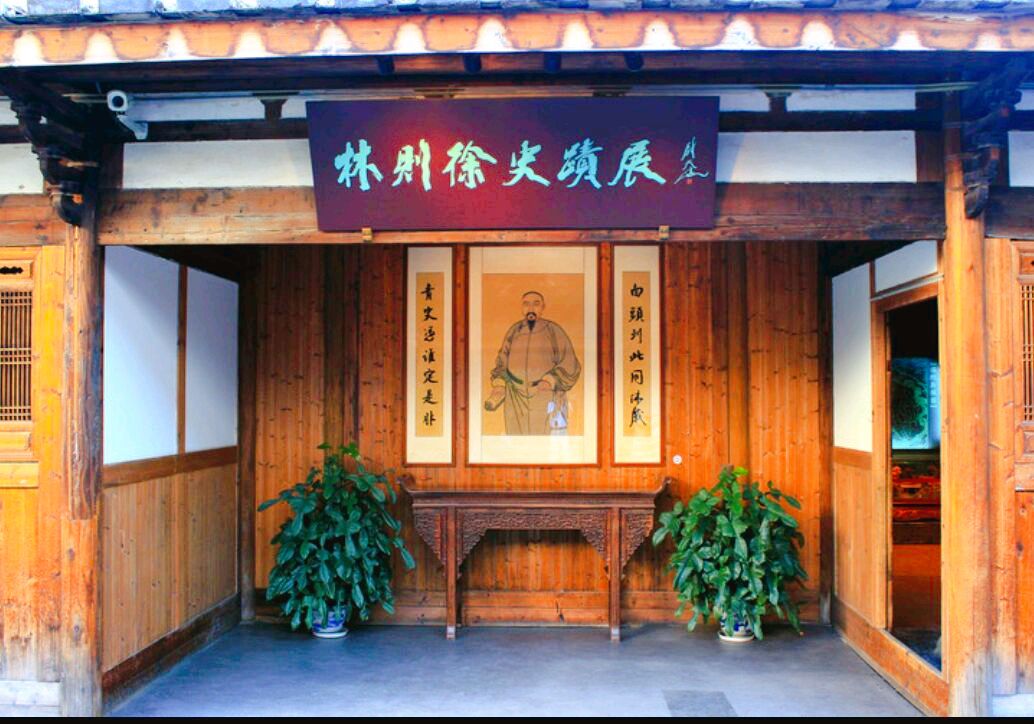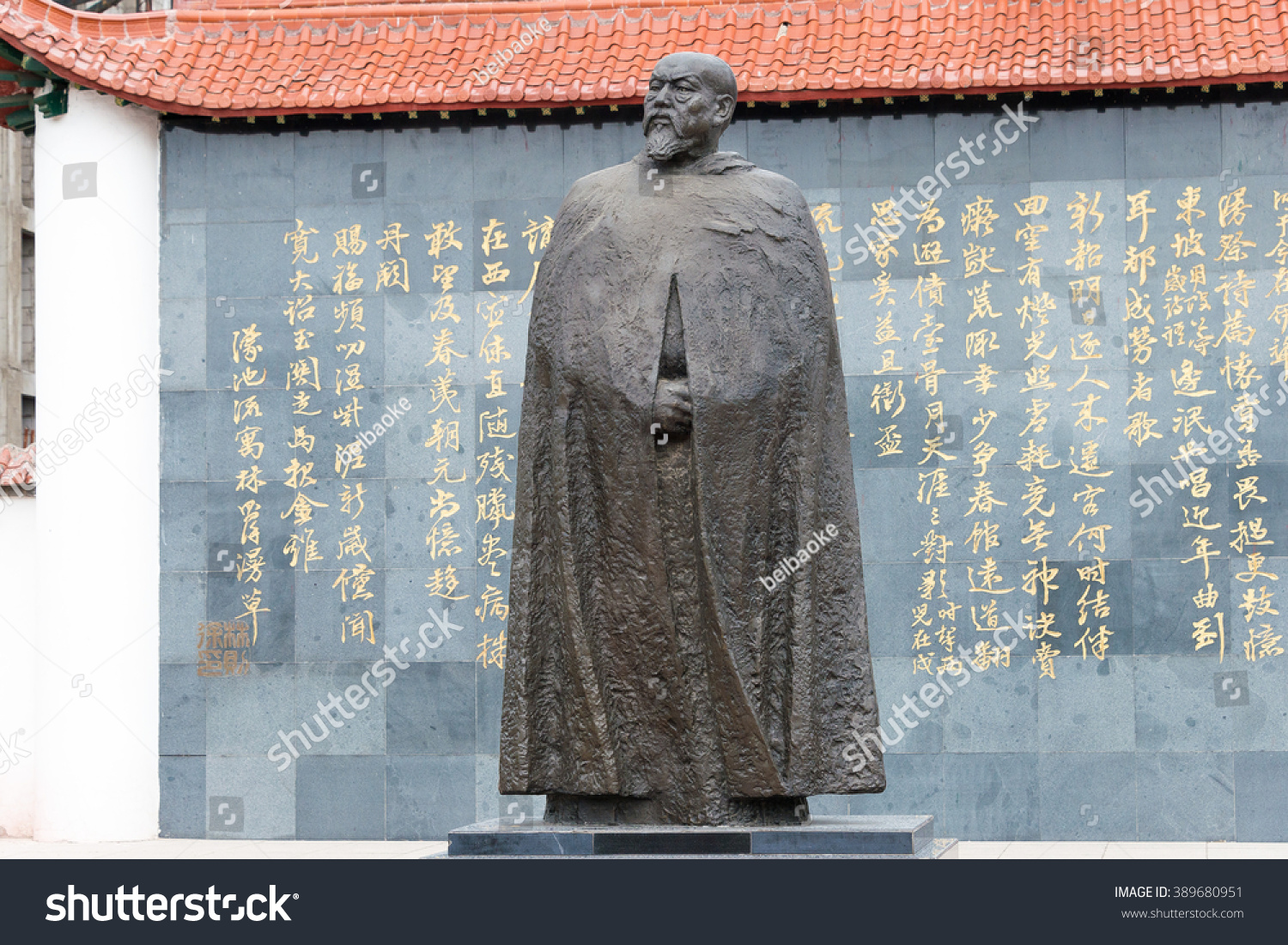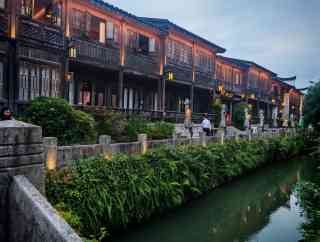Explore the Legacy of Lin Zexu: A Journey to the Lin Zexu Memorial

An Essential Guide to Visiting Lin Zexu Memorial
Nestled in the heart of Macau, the Lin Zexu Memorial Museum serves as a poignant tribute to one of China’s most revered historical figures. This small yet significant museum, dedicated to the life and legacy of Commissioner Lin Zexu, offers international travelers a unique glimpse into the complex tapestry of Chinese history during the late 18th and early 19th centuries. As you step into this serene space, you’ll find yourself immersed in the story of a statesman who stood against the tide of opium trade and fought for the integrity of his nation.
Surrounded by the tranquil grounds of the Lotus Temple, the memorial is not merely a museum; it’s a cultural oasis that invites reflection on the pivotal moments that shaped modern China. With entry priced at a mere 5 MOP, the museum provides an affordable opportunity to explore fascinating exhibitions that detail Lin’s interactions with Western powers and his influential role in the First Opium War.
As you wander through the displays, you’ll encounter not just artifacts and text, but also the spirit of a man who embodied both traditional values and a vision for a more open China. From the striking statue of Lin Zexu that greets you at the entrance to the wooden table used during his negotiations with Portuguese officials, each element tells a part of his story—an inspiring narrative of resilience and reform. Whether you’re a history enthusiast or a curious traveler, the Lin Zexu Memorial Museum is a must-visit stop on your journey through Macau, offering a chance to connect with a pivotal chapter in the region’s rich history.
In This Guide
- An Essential Guide to Visiting Lin Zexu Memorial
- The Rich History and Legends of Lin Zexu Memorial
- Main Highlights: What You Absolutely Can’t Miss
- Planning Your Visit: A Practical Guide
- Tickets: Prices, Booking, and Tips
- How to Get There: A Complete Transportation Guide
- Local Cuisine and Accommodation Nearby
- Frequently Asked Questions
- Final Thoughts on Your Trip
The Rich History and Legends of Lin Zexu Memorial
Nestled in the vibrant cultural landscape of Macau, the Lin Zexu Memorial Museum pays homage to one of China’s most revered historical figures. Lin Zexu was a statesman, scholar, and a formidable advocate for moral integrity and national sovereignty during the turbulent period of the early 19th century. His legacy is intricately woven into the fabric of China’s history, particularly concerning the opium crisis and the subsequent First Opium War.
Lin Zexu (1785-1850) is best remembered for his staunch opposition to the opium trade, which devastated the Chinese populace and economy. Appointed as a special imperial commissioner by the Daoguang Emperor, Lin was tasked with eradicating the opium crisis that had taken hold of his country. His decisive actions in 1839, including the confiscation and destruction of over 1,000 tons of opium in Guangdong, were pivotal moments in Chinese history, symbolizing resistance against foreign exploitation.
Located near the historic Lotus Temple along Ave. Almirante Lacerda, the memorial stands as a testament to Lin’s efforts to bridge the cultural and diplomatic gaps between China and the West. Visitors to the museum can view a striking statue of Lin Zexu at the entrance, flanked by intricately carved stone reliefs that depict significant events from his life, including his negotiations with Portuguese authorities in Macau. One notable artifact housed within the museum is the very wooden table used during those historic discussions, further immersing guests in the story of a man dedicated to his country’s welfare.
While the museum is compact and features an array of text-heavy displays, it allows visitors to explore Lin Zexu’s multifaceted life at their own pace. Sections are organized to highlight his philosophical beliefs, administrative reforms, and the hardline stance he adopted in the face of Western encroachment. The emphasis on his interactions in Macau serves as a reminder of the region’s unique historical role as a point of contact between East and West.
Though modest in size, the Lin Zexu Memorial Museum is rich with stories and lessons from the past. It stands not only as a memorial to a great leader but also as a place of reflection on the broader themes of justice, integrity, and cultural exchange—elements that remain relevant in today’s global society. For those interested in understanding the complexities of Macau’s history and its connections to China, a visit to this memorial can be both enlightening and inspiring.

Lin Zexu Memorial.
Main Highlights: What You Absolutely Can’t Miss
When visiting the Lin Zexu Memorial Museum in Macau, there are several key highlights that you shouldn’t miss, each offering a glimpse into the life and legacy of this pivotal historical figure.
The Grand Statue of Lin Zexu
As you approach the museum, one of the first things to catch your eye is the impressive statue of Commissioner Lin Zexu. Standing proudly in the museum’s courtyard, this statue symbolizes his role as a national hero and a staunch opponent of the opium trade. It’s a perfect spot for a photo to commemorate your visit.
Carved Reliefs
Flanking the entrance to the museum are two captivating carved reliefs that depict significant moments in Lin Zexu’s life. One illustrates his interactions and negotiations with the Portuguese during his time in Macau, while the other shows the dramatic scene of his ordering the destruction of foreign opium in Guangdong. These reliefs offer a visual narrative of his commitment to protecting China from foreign influences.
The Museum Exhibits
Inside, the museum features a series of informative displays chronicling Lin Zexu’s life and contributions. The exhibits are thoughtfully organized into bite-sized sections, allowing you to either take a quick tour or delve deeper into specific aspects of his history. Key topics include his efforts to bridge the gap between protectionist China and the West, as well as his pivotal role in the First Opium War.
The Negotiation Table
One of the museum’s standout pieces is the actual wooden table used during Lin Zexu’s negotiations with Portuguese officials. This historical artifact provides a tangible connection to the past and is a must-see for anyone interested in the intricacies of diplomacy and international relations during the 19th century.
Connection to the Lotus Temple
The Lin Zexu Memorial Museum is located adjacent to the Lotus Temple, a site known for its serene beauty and spiritual significance. This proximity allows for a seamless visit where you can reflect on Lin Zexu’s legacy and then enjoy the tranquil surroundings of the temple, making for a well-rounded experience.
Conclusion
The Lin Zexu Memorial Museum is not just a place to learn about a historical figure; it offers a broader understanding of Macau’s complex history and its interactions with foreign powers. Whether you’re a history buff or simply curious about the cultural dynamics of the region, this museum is an enriching stop that complements your exploration of Macau. Don’t miss the chance to engage with the past and appreciate the contributions of one of China’s most important statesmen!

Lin Zexu Memorial.
Planning Your Visit: A Practical Guide
Visiting the Lin Zexu Memorial Museum in Macau offers a unique opportunity to delve into the rich tapestry of Chinese history, particularly during the late Qing Dynasty. This practical guide will help you make the most of your visit to this significant cultural site.
Location and Accessibility
The Lin Zexu Memorial Museum is situated approximately 800 meters from the immigration border gate between China and Macau, making it an easily accessible destination. The museum is located in the north of the Macau Peninsula, adjacent to the historically significant Lotus Temple, which adds to the contextual experience of your visit.
Opening Hours and Admission
The museum is open daily from 9:00 AM to 5:00 PM, except Mondays when it is closed. Entry is affordable, with a ticket costing only 5 MOP (Macanese Patacas), allowing you to explore the exhibits without breaking the bank.
What to Expect
As you approach the museum, you’ll be greeted by a large statue of Commissioner Lin Zexu, a prominent Chinese official known for his role in the opium trade crisis of the 19th century. The museum itself is modest in size and is designed more like a local temple than a traditional museum.
Inside, the displays focus on significant events in Lin Zexu’s life, particularly his interactions with Western powers and his efforts against opium. The exhibits are organized into bite-sized sections, making it easy to navigate through the historical content, whether you prefer a quick visit or a more in-depth exploration. Notably, you can see the original wooden table used during negotiations with Portuguese officials.
Highlights of the Museum
- Statue of Lin Zexu: A striking landmark that serves as the museum’s focal point.
- Historical Carvings: These artworks depict critical moments in Lin Zexu’s life, including his orders to destroy foreign opium in Guangdong.
- Educational Displays: While some reviews mention that the exhibits can be text-heavy, they provide valuable insights into Lin Zexu’s philosophies and his attempts to bridge cultural divides between China and the West.
Combining Your Visit
Given its proximity to the Lotus Temple, consider pairing your museum visit with a stop at this beautiful site. The temple, known for its serene atmosphere and architectural beauty, provides a peaceful contrast to the historical narratives explored at the museum. Additionally, you can easily explore other nearby attractions such as the Ruins of St. Paul’s, the Macao Museum, and the Historic Centre of Macau, all within walking distance.
Dining Options Nearby
After your visit, indulge in some local cuisine at one of the nearby restaurants. Here are a few highly-rated options:
- The Conservatory: A Chinese eatery offering vegetarian-friendly options, located just 0.4 miles away.
- Copa Steakhouse: A slightly upscale dining experience with a diverse menu, about 0.8 miles from the museum.
- Mesa By José Avillez: A European restaurant that is well-reviewed and located 0.9 miles away.
Final Tips
- Plan Your Timing: Aim to visit during the morning to avoid crowds, especially on weekends.
- Engage with Staff: Don’t hesitate to ask museum staff for insights or recommendations on what to see.
- Wear Comfortable Shoes: As you may do a bit of walking to explore the surrounding area, comfortable footwear is advisable.
With its rich historical context and the serene setting of the Lotus Temple nearby, the Lin Zexu Memorial Museum is a meaningful stop for anyone interested in the complexities of Macau’s past and its cultural heritage. Enjoy your visit!

Lin Zexu Memorial.
Tickets: Prices, Booking, and Tips
Visiting the Lin Zexu Memorial Museum in Macau is an excellent opportunity for travelers interested in history and culture. The museum, dedicated to the influential figure Commissioner Lin Zexu, is conveniently located near the Lotus Temple, making it an easy addition to your itinerary.
Ticket Information:
– Admission Fee: Entry to the Lin Zexu Memorial Museum is a mere 5 MOP (Macanese Patacas), making it an affordable attraction for all visitors.
– Opening Hours: The museum welcomes guests daily from 9 AM to 5 PM, but it remains closed on Mondays. Planning your visit around these hours will ensure you have ample time to explore the exhibits.
Booking Tips:
– No Advance Booking Required: Visitors do not need to book tickets in advance; simply arrive at the museum during operating hours and pay at the entrance.
– Cash Payment: It’s advisable to carry cash, as some smaller venues may not accept credit cards. The 5 MOP entry fee can be paid in cash upon entry.
Visitor Experience:
Expect a museum that leans more towards a cultural park than a traditional museum. While the displays are primarily text-based and arranged in manageable sections, you can navigate through the exhibits quickly or take your time to delve into Lin Zexu’s significant contributions to Chinese history, particularly regarding his encounters with foreign powers and his role in the opium crisis.
For an enriching experience, consider combining your visit with a stroll around the beautiful Lotus Temple nearby, enhancing your understanding of this historically rich region. The museum’s small size and low entry fee make it a worthwhile stop for those looking to deepen their knowledge of Macau’s history and its important figures.
How to Get There: A Complete Transportation Guide
To visit the Lin Zexu Memorial Museum in Macau, navigating the city’s transportation options is essential for a smooth journey. Located in a tranquil park setting adjacent to the Lotus Temple, the museum offers a glimpse into the life of the influential Chinese statesman Lin Zexu. Here’s how to get there:
Arriving in Macau
By Air:
Macau International Airport (MFM) is the primary airport serving the region. It offers flights from various international destinations. After landing, you can take a taxi or a shuttle bus to reach the city center.
By Ferry:
Ferries from Hong Kong to Macau are frequent and take about an hour. The Outer Harbour Ferry Terminal is the main arrival point in Macau. From there, you can easily access local transportation options.
Getting to Lin Zexu Memorial Museum
1. From the Airport:
– Taxi: The most convenient way to reach the museum from the airport is by taxi, which takes about 15-20 minutes, depending on traffic. Ensure the driver understands your destination, or show them the museum’s address (located at Ave. Almirante Lacerda).
– Bus: Alternatively, you can take Bus 26 from the airport to the city center and then transfer to Bus 3 or Bus 10, which will take you closer to the museum.
2. From the Outer Harbour Ferry Terminal:
– Taxi: A taxi ride from the ferry terminal to the museum will take approximately 10 minutes. Just tell the driver to take you to the Lin Zexu Memorial Museum.
– Bus: You can also take Bus 3 or Bus 10 directly from the terminal. This option is economical and allows you to experience more of the local scenery.
3. Walking from Nearby Attractions:
If you’re visiting other nearby sites, such as the Lotus Temple or the Ruins of St. Paul’s, the Lin Zexu Memorial Museum is about a 10-15 minute walk away. Simply head towards Ave. Almirante Lacerda, where the museum is easily accessible.
Public Transportation Tips
- Bus System: Macau’s bus system is affordable and efficient. Ensure you have some Macanese Patacas (MOP) for fare; exact change is usually required.
- Taxi Services: Taxis are widely available and relatively inexpensive. Note that most drivers speak limited English, so having your destination written down can be helpful.
- Walking: The area around the museum is pleasant for walking, allowing you to enjoy the local architecture and parks.
Accessibility
The Lin Zexu Memorial Museum is situated in a park that is generally accessible. However, if you have mobility concerns, it’s advisable to check with your taxi driver about the best drop-off point to minimize walking distance.
Final Thoughts
Visiting the Lin Zexu Memorial Museum is not only an enriching historical experience but also an opportunity to appreciate the serene environment of Macau. With several transportation options at your disposal, reaching this cultural gem is a breeze. Enjoy your visit!

Lin Zexu Memorial.
Local Cuisine and Accommodation Nearby
When visiting the Lin Zexu Memorial Museum in Macau, you’re not just stepping into a place of historical significance; you’re also in a vibrant area filled with culinary delights and comfortable accommodations. Here’s a guide to enhance your experience:
Dining Options
-
The Conservatory
Just a short stroll away, The Conservatory offers a modern twist on Chinese cuisine along with bar options. With a score of 4.9 out of 5, it’s a favorite for both locals and tourists. The ambiance is inviting, making it perfect for a relaxing meal after exploring the museum. -
Utm Educational Restaurant
This unique dining experience combines European and Portuguese influences with a focus on vegetarian-friendly dishes. Rated 4.6, it’s an excellent spot for those looking to enjoy a hearty meal while learning about food preparation in a friendly environment. -
Golden Court (Sands Macao)
If you’re in the mood for seafood or traditional Chinese flavors, Golden Court is a highly recommended choice, boasting a 4.8 rating. It’s just a stone’s throw from the museum, allowing you to savor local dishes after immersing yourself in history. -
Copa Steakhouse
Located slightly further but well worth the visit, Copa Steakhouse offers an upscale dining experience with a European flair. With a 4.8 rating, it’s a fantastic spot for steak lovers looking to indulge. -
Mesa By José Avillez
For a high-end dining experience, look no further than Mesa, rated 4.9. This spot delivers an exquisite menu crafted by the renowned chef José Avillez, making it an excellent choice for food enthusiasts.
Accommodation Recommendations
-
Grand Lisboa Hotel
Just under a mile from the museum, this luxury hotel offers elegant rooms and world-class service. With its breathtaking views and top-notch amenities, it’s perfect for travelers seeking both comfort and indulgence. -
Hotel Lisboa
A historic landmark in Macau, Hotel Lisboa combines traditional charm with modern conveniences. It’s conveniently located near several attractions, making it ideal for exploring the city. -
Casa Real Hotel
This mid-range hotel is a great choice for budget-conscious travelers without sacrificing quality. Located close to the Lin Zexu Memorial Museum, it provides comfortable rooms and easy access to various dining options. -
Hotel Royal Macau
Offering a blend of luxury and affordability, Hotel Royal Macau is another excellent option. It features spacious accommodations and is just a short distance from the museum and other key attractions. -
Holiday Inn Macau
A family-friendly option, this hotel offers modern amenities and a welcoming atmosphere. Its location makes it easy to explore the cultural sites around the city, including the Lin Zexu Memorial.
Bonus Tips
After your visit to the Lin Zexu Memorial Museum, consider taking a leisurely walk to the nearby Lotus Temple, which is rich in history and tranquility. Pair your cultural exploration with a delicious meal from one of the recommended restaurants, and unwind at a comfortable hotel to reflect on your day. Enjoy the culinary and hospitality treasures Macau has to offer!

Lin Zexu Memorial.
Frequently Asked Questions
Frequently Asked Questions about Lin Zexu Memorial
-
What is the Lin Zexu Memorial Museum?
The Lin Zexu Memorial Museum is dedicated to the life and contributions of Commissioner Lin Zexu, an important Chinese official and philosopher from the late 18th to early 19th century. The museum showcases his efforts against the opium trade and his role in negotiations with foreign powers, particularly Portugal. -
Where is the museum located?
The museum is situated near the Lotus Temple along Avenida Almirante Lacerda, approximately 800 meters from the immigration border gate between China and Macau, making it easily accessible for visitors. -
What are the opening hours and entry fees?
The museum is open daily from 9 AM to 5 PM, but it is closed on Mondays. The entry fee is just 5 patacas (MOP), making it an affordable stop for travelers. -
Is the museum suitable for visitors who are not familiar with Chinese history?
Absolutely! While the museum contains informative displays about Lin Zexu’s life and historical context, the exhibits are organized into bite-sized sections that make it easy to understand, even for those unfamiliar with the subject matter. -
What can I expect to see inside the museum?
Inside, you’ll find a variety of text-based displays, including a replica of the wooden table used during Lin Zexu’s negotiations. You’ll also see carvings that depict significant moments in his life, such as his efforts against the opium trade and his interactions with Portuguese officials. -
Can I combine my visit to the museum with other attractions?
Yes! The Lin Zexu Memorial Museum is conveniently located near the Lotus Temple and other historic sites in Macau, such as the Ruins of St. Paul’s and the Macao Museum, allowing for a well-rounded cultural experience. -
Is there any specific etiquette I should follow when visiting the museum?
While the museum is open to all visitors, it’s always respectful to observe general museum etiquette: speak softly, refrain from touching exhibits, and be mindful of other guests. If you are visiting during a busy time, patience is appreciated. -
Are there dining options nearby?
Yes, there are several restaurants and cafes within a short walking distance from the museum, offering a variety of cuisines, including Chinese, Portuguese, and international dishes. It’s a great opportunity to enjoy a meal after immersing yourself in history!
Final Thoughts on Your Trip
As you conclude your visit to the Lin Zexu Memorial Museum, take a moment to reflect on the rich tapestry of history that this small yet significant site represents. Nestled near the renowned Lotus Temple, the museum offers a unique glimpse into the life of a pivotal figure in Chinese history, Commissioner Lin Zexu. His courageous efforts against opium trade and his attempts to bridge East and West continue to resonate in today’s world.
While the museum itself may be modest in size and exhibits, it is steeped in profound stories and cultural significance. The wooden negotiation table and the surrounding carvings serve as reminders of a turbulent era that shaped the future of China and its interactions with foreign powers.
Whether you are a history enthusiast or simply curious about the intertwining narratives of Macau and China, the Lin Zexu Memorial Museum invites you to ponder the complexities of diplomacy, national pride, and the quest for justice. Pair your visit with a leisurely stroll through the adjacent gardens or continue exploring the vibrant streets of Macau, where every corner tells a story.
In essence, your journey to the Lin Zexu Memorial Museum is not just a visit to a museum; it’s an invitation to engage with history and reflect on its lasting impact. As you depart, carry with you the spirit of inquiry and understanding that Lin Zexu exemplified, and let it inspire your future travels.